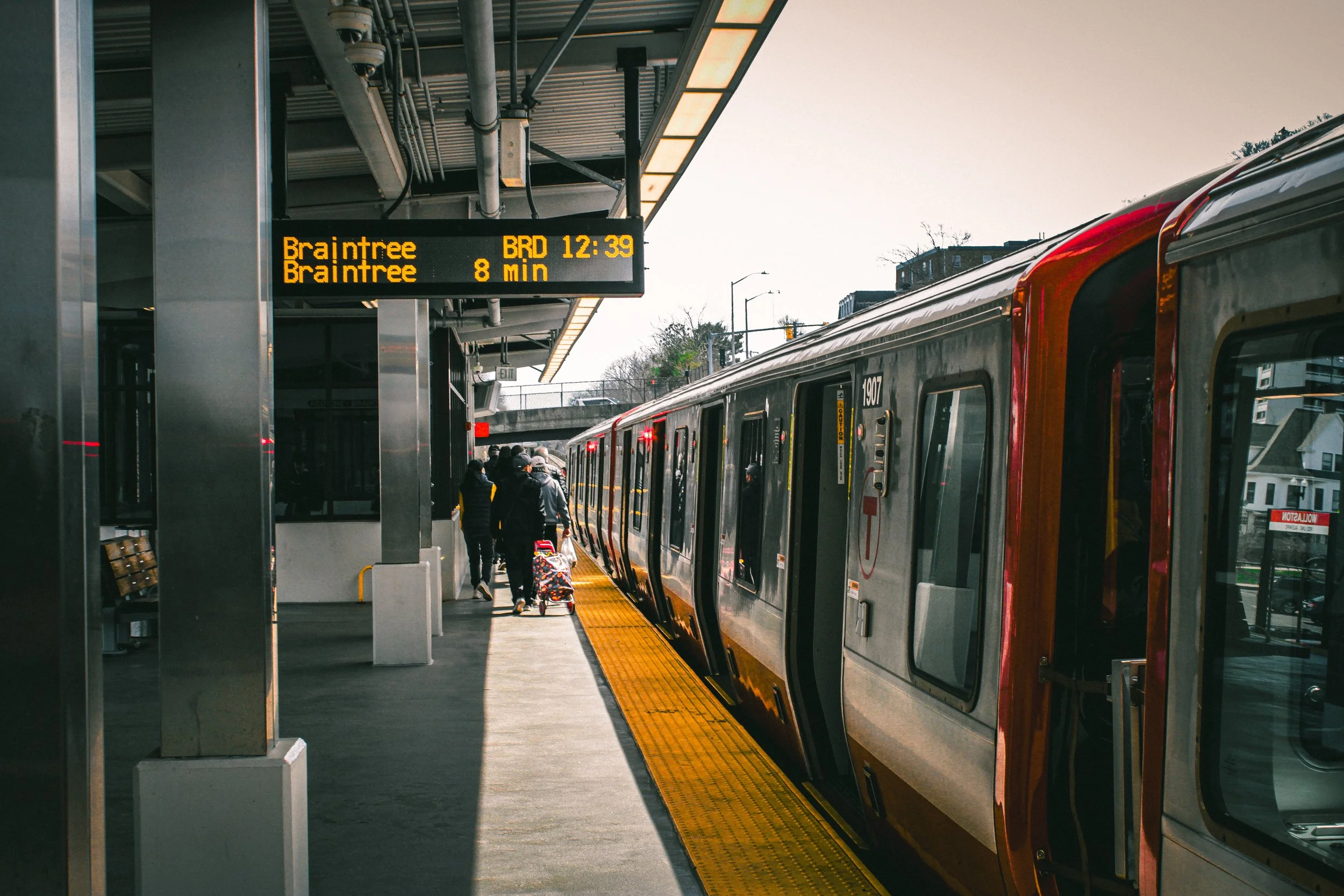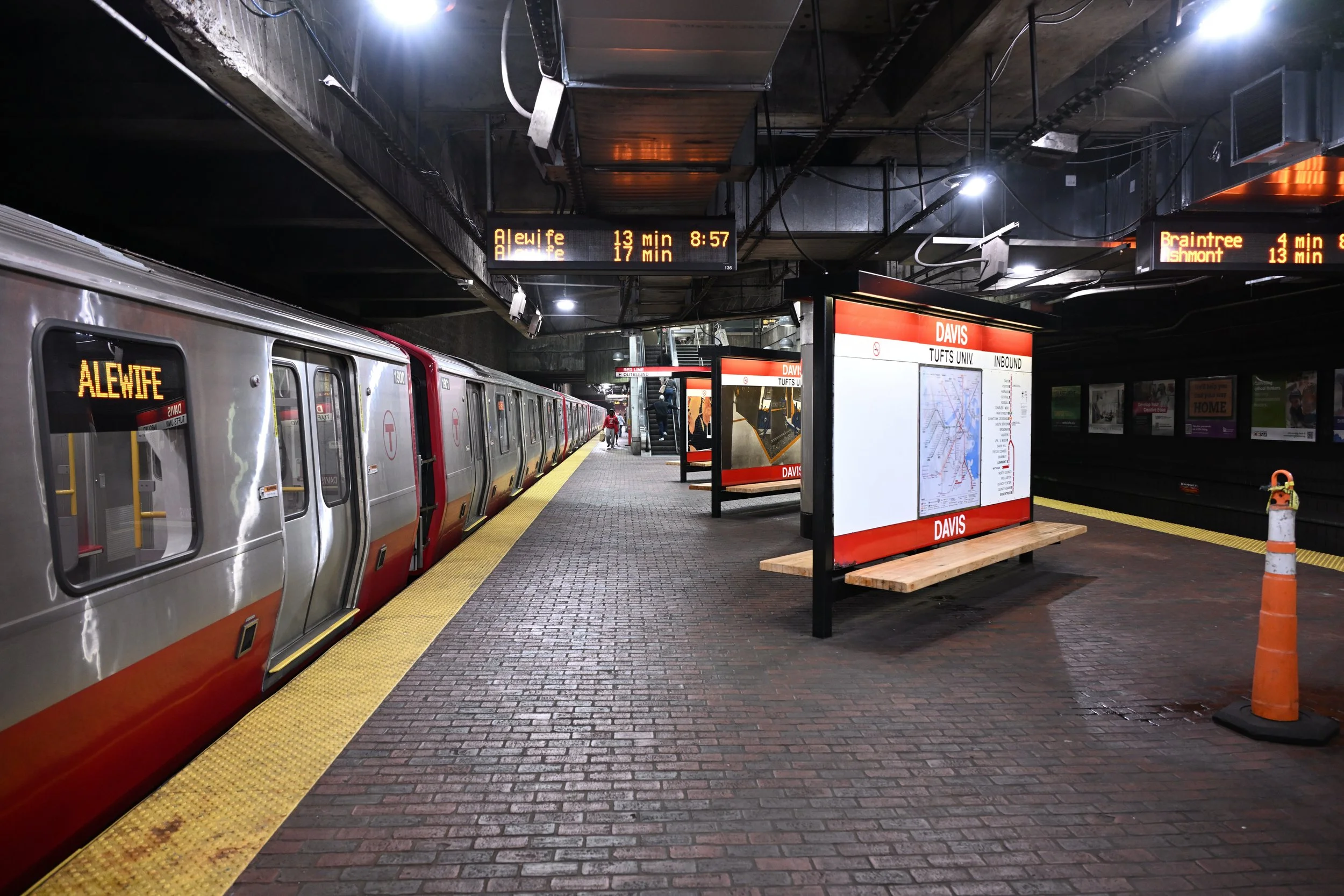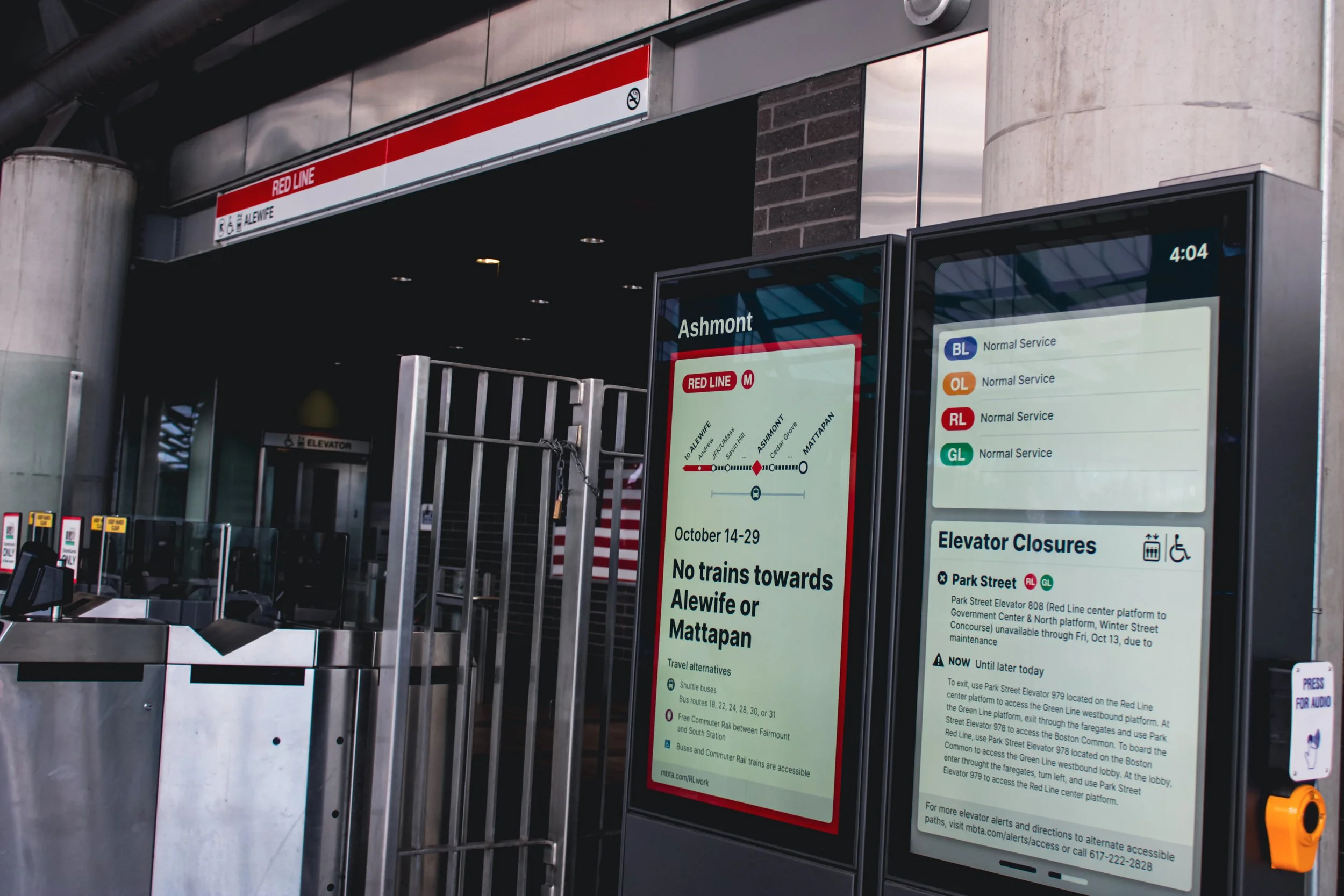
TransitMatters Analysis: South Shore, Slow no more
Even with the few slow zones that still remain on the Red Line today, this work marks a monumental point in the T’s efforts to eliminate slow zones across the network and fortify transit across the region.
BOSTON, October 9, 2024 — On September 6, 2024, the MBTA began a 24-day shutdown on the Red Line Braintree Branch, suspending service between JFK/UMass and Braintree to complete critical trackwork.
On September 30, 2024, the MBTA claimed it removed 37 speed restrictions across 18 miles of track, improving round-trip Braintree Branch travel times by 24 minutes. And based on our analysis, the agency did exactly that!
Here are the big takeaways from the shutdown:
The T delivered! The Red Line Braintree Branch is slow zone-free, and the entire Red Line is nearly slow zone-free.
This resulted in a time saving of nearly half an hour round-trip for riders.
PRE-SHUTDOWN
In January 2021 (the last month that the Red Line had no slow zones), the average travel time northbound between JFK/UMass and Braintree was 19 minutes and 25 seconds and 21 minutes and 22 seconds southbound.
By the end of August 2024—a week before the shutdown—the average travel time northbound between JFK/UMass and Braintree was 33 minutes and 41 seconds and 31 minutes and 27 seconds southbound.
POST-SHUTDOWN
A week following the shutdown, the average northbound travel time between JFK/UMass and Braintree was 18 minutes and 5 seconds and 19 minutes and 3 seconds southbound for over 27 minutes of saved round-trip travel time, as the T promised. Our Slow Zone Tracker also shows that the T removed all slow zones on the Braintree Branch.
This shutdown, a critical part of the Track Improvement Plan (TIP), was vital to improving service and reliability for the thousands of riders the Red Line sees weekly. Along with the trackwork, the T made essential station repairs and improvements, including repairs to the pedestrian overpass and roof at JFK/UMass Station.
Riders impacted by this shutdown were among the hardest hit, overwhelming alternative Commuter Rail and shuttle service capacity. However, following this shutdown, the MBTA hopes to see Red Line speeds return to 40 mph and potentially increase to 50 mph.
Still, a couple of slow zones remain today. In both directions, between JFK/UMass and Andrew, riders see 46 to 69 seconds of delay. Southbound from Central to Kendall/MIT, riders are seeing 28 seconds of delay. The T will address these remaining slow zones in brief shutdowns in November.
Two remaining Red Line shutdowns planned for this year will hopefully remove the final three slow zones on the Red Line.
November 5–10: Broadway to North Quincy
November 18–24: Harvard to Broadway
Even with the few slow zones that still remain on the Red Line today, this work marks a monumental point in the T’s efforts to eliminate slow zones across the network and fortify transit across the region.
To keep up with all things MBTA shutdowns, please visit mbtashutdowns.info.
Photo credit: Brooke Winter
TransitMatters Analysis: A Cause for Celebration as Red Line Slow Zones are Removed, Students Rejoice
Compared to early July, there are 3.6-minute savings northbound and 77-second savings northbound, bringing travel times back in line with pre-COVID averages.
Boston, August 19, 2024 — On June 18, the MBTA announced that it would shut down sections of the Red Line throughout July for the following days:
Between Alewife and Kendall on the evening of July 12 and during July 15–26
Between Alewife and JFK/UMass, the weekends of July 13–14 and July 27–28
Between Alewife and Park Street during the weekend of July 20–21 and the evenings of July 15–26
On July 30, the MBTA announced the shutdown's successful conclusion. The T removed nine speed restrictions, two more than initially planned, among other improvements.
Here are the big takeaways from the shutdown:
The T fixed nearly all track-related slow zones between Alewife and Kendall/MIT, resulting in almost five minutes of travel time savings (nearly in line with pre-COVID travel times)
The T’s extension of the shutdown to Park Street and JFK/UMass on weekends didn’t produce travel time savings for riders, but it did allow the T to remove five miles of scrap rail from the right of way as it had intended.
The semester speeds ahead
Removing the notorious slow zones between Harvard and Kendall/MIT will be a significant relief for students. Late last year, The Harvard Crimson published an op-ed describing a student's 38-minute commute from Alewife to Park Street. Luckily for this student, since the publication of this article, the average commute between those two stops has dropped by nearly 12 minutes, a 40% decrease. The latest shutdown, just in time for the fall semester, contributed around five minutes to the decline.
PRE-SHUTDOWN
In January 2021 (the last month that the Red Line had no slow zones), the average travel time northbound between Alewife and Kendall/MIT was 14 minutes and 14 seconds and 12 minutes and 58 seconds southbound.
By July 2024, the average travel time northbound between Alewife and Kendall/MIT was 17 minutes and 27 seconds and 15 minutes and 5 seconds southbound.
POST-SHUTDOWN
In the weeks following the shutdown, the average travel time northbound between Alewife and Kendall/MIT was 13 minutes and 39 seconds and 13 minutes and 48 seconds southbound - a savings of 4.8 minutes of travel time between Alewife and Kendall/MIT.
Compared to early July, there are 3.6-minute savings northbound and 77-second savings northbound, bringing travel times back in line with pre-COVID averages. Woohoo!
Riders may wonder why their trip through downtown has not yet improved despite the shutdown extending to Park Street or JFK/UMass on weekends and evenings. However, the MBTA announced that this extension allowed materials to be brought in and scrap rail removed rather than to fix additional slow zones.
Other closures under the Track Improvement Plan have maximized the efficiency of shutdowns by making additional improvements to stations as well. The T welcomed back Red Line riders with cleaner and fresher stations, some of which have received retiling, a powerwash, new lighting, and more.
The T still has some work to do. One slow zone, which slows riders down by half a minute, remains between Central and Kendall/MIT, as well as a group of slow zones between Kendall and Park Street. An additional Red Line shutdown is scheduled between Kendall/MIT and JFK/UMass between August 19 and 25.
This shutdown was originally scheduled for October but was moved to accommodate the academic calendar. The bulk of the slow time on the Red Line remains between JFK/UMass and Braintree. The MBTA plans to address these Braintree branch slow zones with a 24-day shutdown between September 6 and 29.
To keep up with all things MBTA shutdowns, please visit mbtashutdowns.info.
###
Photo Credit: James Wang
TransitMatters Analysis: Fast Work On Slow Zones
On October 30, the MBTA announced the successful completion of the shutdown and that “all speed restrictions that were in place prior to the shutdown have been alleviated in this area.” TransitMatters wondered: did the T, as Eng promised, clear this section of the system of slow zones?
The southbound section between JFK/UMass Station and Savin Hill Station remained the only segment with speed restrictions as of November 6, 2023.
BOSTON, November 6, 2023 — On August 24, the MBTA announced that it would shut down the Ashmont Branch of the Red Line and the Mattapan Line from October 14 to October 29 to expedite critical track work. The agency claimed it would otherwise take six months of night and weekend diversions to complete. MBTA General Manager Phillip Eng assured the public that 28 speed restrictions present on that section of the system would be lifted following the completion of the shutdown, resulting in faster travel times for the 40,000 riders traveling on the Ashmont Branch and 3,700 riders traveling on the Mattapan Line every day.
On October 30, the MBTA announced the successful completion of the shutdown and that “all speed restrictions that were in place prior to the shutdown have been alleviated in this area.” TransitMatters wondered: did the T, as Eng promised, clear this section of the system of slow zones?
While the MBTA maintains its own dashboard showing the state of slow zones across the system, our algorithm predates the T’s official reports. We visualize this using our Data Dashboard and proactively communicate both new and fixed slow zones to the public via our Slow Zone Bot, which posts to X, the platform formerly known as Twitter, as well as Mastodon. Using these tools, we analyzed the shutdown and the work done on the Ashmont Branch and Mattapan Line to answer our original question. Our analysis will focus on the Ashmont Branch.
PRE-SHUTDOWN
In October 2018, the average travel time between JFK/UMass Station (where the Ashmont and Braintree Branches of the Red Line diverge) and Ashmont Station was 9 minutes and 38 seconds southbound and 8 minutes and 33 seconds northbound, with no slow zones present on the branch.
By September 2023, this average travel time was up to 17 minutes and 6 seconds southbound and 15 minutes and 7 seconds northbound, almost double the average travel times. The entirety of the Ashmont Branch had a slow zone of some kind—northbound, southbound, and between all stations. It is worth pointing out that by the T’s numbers, this degradation of just the Ashmont Branch has resulted in a collective 390 days of slow time for riders every day, assuming a round trip for each of 40,000 daily riders. Roughly the same number of people were affected by the Sumner Tunnel shutdown. Despite this, the state government has generally paid more attention to the state of the Sumner Tunnel than that of the Red Line.
OCTOBER 30 (DAY ONE)
The first day the Ashmont Branch and Mattapan Line reopened, the MBTA claimed it removed all speed restrictions, improving travel times by over 10 minutes for Ashmont Branch and Mattapan Line riders. Our data shows that travel times between JFK/UMass and Ashmont took an average of 12 minutes and 26 seconds southbound and 10 minutes and 44 seconds northbound. Compared to pre-shutdown travel times, travel times improved by 4 minutes and 40 seconds southbound and 4 minutes 23 seconds northbound. Combined with improvements to the Mattapan Line, it is fair to say the MBTA did improve travel times by over 10 minutes for riders.
However, not all speed restrictions, or slow zones, were removed on Day One. Our Slow Zone Tracker shows that several speed restrictions remained on October 30. That’s not to say that the T was entirely incorrect on this claim. We have seen in previous shutdowns that slow zones can persist—due to, for example, track settling or operators acclimating to new track conditions. As a result, we wanted to continue our analysis for the remainder of the week to see if that was the case here.
OCTOBER 31
Day Two did see further improvements in travel times for the Ashmont Branch. Our data shows that travel between JFK/UMass and Ashmont took an average of 9 minutes and 48 seconds southbound and 9 minutes and 1 second northbound—a combined further travel time improvement of 4 minutes and 21 seconds. Our Slow Zone Tracker shows many of the slow zones that persisted on day one had disappeared by day two. The southbound section between JFK/UMass Station and Savin Hill Station remained the only segment with speed restrictions.
NOVEMBER 1-5
Days Three to Seven saw operations stabilize to fairly consistent travel times on both directions of the line, perhaps stemming from operators becoming more accustomed to the new speeds allowed for by the track work. Travel times between JFK/UMass and Ashmont took on average 8 minutes and 56 seconds southbound and 8 minutes northbound—an overall travel time improvement of 15 minutes 17 seconds for a round trip compared to September 2023 averages. A single slow zone between JFK/UMass and Savin Hill southbound has persisted. However, we should note: that zone has seen substantial speed improvement, and riders have still seen massive time savings on the branch.
CONCLUSIONS
Below is a table summarizing our day-to-day analysis of the performance of the Ashmont Branch in the week following the shutdown, with the October 2018 and September 2023 numbers included for comparison.
We can visualize the above table with the Data Dashboard:
Here is an overview of the line from the beginning of September to now, southbound.
And here is that same overview for the line northbound.
From all this data we can make several conclusions:
The shutdown resulted in the restoration of historic travel times. Red Line trains are finally moving along the Ashmont Branch as fast as they did in 2018, resulting in over a year of collective time saved by riders every day.
General Manager Eng was correct about his statement regarding travel times; however, somewhat missed the mark with his claim of immediate removal of all speed restrictions. While the majority of speed restrictions did dissipate during the week, several restrictions remained on the first day of reopening. Eng’s statement shows a step in the right direction for honest communication from the MBTA to the public. However, the T needs to work on transparency for the general public to regain trust in the MBTA and its leadership.
Shutdowns only work if they are properly planned, communicated, and executed. Last year, the MBTA announced the month-long Orange Line shutdown with barely two weeks of notice for riders and produced disappointing results. Already, the Ashmont Branch and Mattapan Line shutdown has yielded more positive feedback, proving these shutdowns can work if you give riders adequate time to prepare, viable alternative forms of transportation, and, most importantly, tangible results to show for the inconvenience.
We applaud the MBTA for the measures they took to ease the pain of this shutdown for riders. The agency created a tailored Riders’ Guide to help riders find alternative travel options, and allowed riders to show their CharlieCard to ride free on the Fairmount Line, a line that TransitMatters has identified as a high-priority candidate for electrification and conversion to a Regional Rail model. We hope the popularity of the Fairmount Line as an alternative during this shutdown encourages the state legislature and MBTA to prioritize those enhancements to that line and continue using Commuter Rail alternatives during future shutdowns.
At JFK/UMass Station, the T utilized the extended closure to install new floors, apply fresh paint, and deep clean. Continued efforts to improve stations helps enhance the rider experience, which is key to retaining riders during extended diversions. While riders can feel the work done through a faster ride, riders need to see the work as well.
Ultimately, TransitMatters would like to see the MBTA continue with similar expedited closures to alleviate all slow zones system-wide. With the exciting success of the Ashmont Branch and Mattapan Line shutdown, the MBTA should promptly create and release a strategy and calendar of future diversions intended to fix slow zones.
For media inquiries, please e-mail media@transitmatters.org.
###
Banner Photo Credit: Brooke Winter
Categories
- Children (1)
- Diversions (1)
- Olympics (1)
- MAPC (2)
- Red–Blue Connector (2)
- Urban Design (3)
- Bus (4)
- Fares (4)
- Late Night Service (4)
- MBTA ROC (4)
- Silver Line (4)
- Snow (5)
- Blue Line (8)
- Emergency (8)
- Orange Line (8)
- Public Comment (8)
- Maintenance (9)
- Operations (9)
- Signage (9)
- Fare Collection (10)
- Labs (11)
- Safety (11)
- Planning (12)
- Communication (14)
- MBCR (14)
- MassDOT (14)
- Green Line (16)
- History & Culture (16)
- Red Line (18)
- MBTA Bus (21)
- Commuter Rail (24)
- Advocacy (26)
- Capital Construction (28)
- Politics (30)
- Podcast (35)
- News (38)
- Media (40)
- Funding (42)
- Statements (50)
- MBTA (57)












